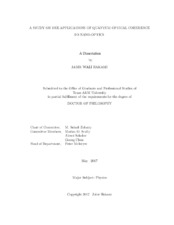| dc.description.abstract | Optically controlled dipole-dipole interaction at submicrometers and subwavelength scales leads to many interesting phenomenon and remarkable potential applications in quantum optics, condensed matter physics, and today’s micro-devices. In this dissertation, we study the applications of quantum optical coherence to nano-optics in the following systems and aspects. On the one hand, chiral metamaterials has been previously reported as excellent candidates to realize both attractive and repulsive Casimir forces, where the existence of a repulsive Casimir force depends upon the strength of the chirality. On the other hand, nanoscale integration of metal nanoparticles and semiconductors is particularly interesting because the strengths of both materials are combined in such a hybrid system. In the first part of this work, we proposed a technical scheme to coherently control of the Casimir interaction energy with two identical chirality mediums. We took explicit caution regarding the requirements of passivity and causal response of the materials, since these requirements are essential for the application of the Lifshitz formula. The rare-earth metals’ atomic species, for instance, dysprosium, is proposed as an applicable medium for the forthcoming studies of possible experimental implementation of our technique. Secondly, we fully investigated the coherent control of the quantum optical properties of spontaneous emission spectra of a semiconductor quantum dot coupled to a metallic nanoparticle. The properties of the spontaneous emission spectra of such a system are studied in detail with and without involving the coherent field. The Rabi splitting effect in the spectrum emitted by the quantum dot under particular conditions is predicted for different sizes of the metal nanoparticles. We show that the spontaneous emission spectra of the transition coupled to surface plasmons may be further modified by adjusting the external coherent control on the adjacent transitions. In the third part, we propose a robust protocol to study the entanglement generation in a hybrid structure consisting of two quantum dots in the proximity of a metallic nanoshell. The entanglement arises impulsively due to common coupling to the plasmonic nanostructure, without demanding postselective measurement or mediating the dissipative environment. The long-lived entangled states can be created deterministically by optimizing the shell thickness as well as the ratio of the distances between the quantum dots and the surface of the shell. The loss of the system is greatly reduced even when the quantum dots are ultraclose to the shell, which signifies a slow decay rate of the coherence information and longtime entanglement preservation. | en |


